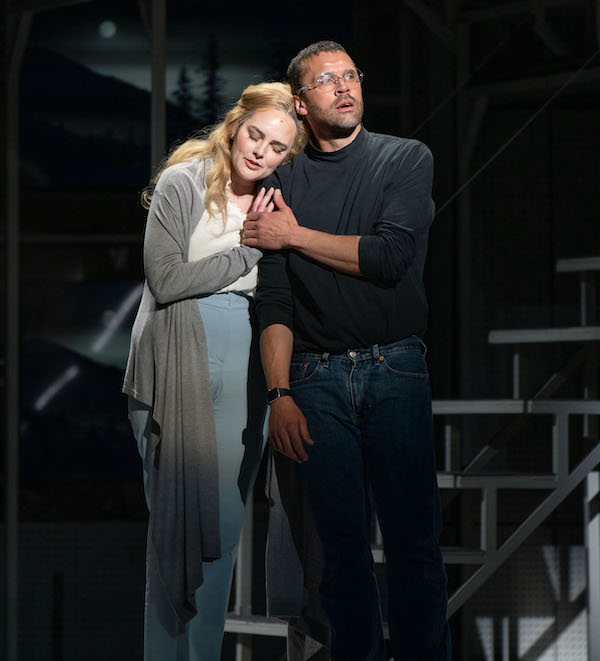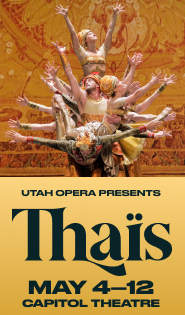Music, high-tech visuals make up for uneven libretto in Utah Opera’s “The (R)evolution of Steve Jobs”

A note at the end of the Utah Opera program synopsis states that Mason Bates and Mark Campbell’s The (R)evolution of Steve Jobs “does not purport to depict actual events as they occurred.”
Indeed, this 2017 opera isn’t the place to find profound insights into the man whose creative vision revolutionized the way billions of people communicate. The dramatic arc—flawed genius loses sight of what’s truly important but is brought back around by people who love him—is hardly unique to Steve Jobs, and the opera’s “don’t live your life on your phone” moral feels facile. But the production that opened Saturday night has more than enough musical and visual thrills to make up for these shortcomings.
Serendipitously enough, the high-tech nature of this production allowed for a virtually seamless adaptation when faced with a potential opening-night disaster. Soprano Amy Owens was unable to appear on stage due to illness Saturday night, but instead sang the role of Chrisann Brennan from a remote location while director Rebecca Herman acted the role onstage. This could be the first time in opera history where an artist literally phoned in a role. The show went on and the production did not suffer.
The opera unfolds in twenty vignettes that zigzag gently through time, touching on key moments and relationships in Jobs’s life. With a running time of only a hundred minutes, the score itself has an important role in propelling the story and illuminating the characters: frenetic and electronics-heavy for Jobs; high, ethereal, and woodwind-dominated for his free-spirited hippie girlfriend, Brennan; lyrical with swelling strings for his soulmate, Laurene Powell Jobs; amiably jazzy for creative partner Steve Wozniak; Eastern-inflected for Zen mentor Kōbun Chino Otogawa. Bates’s inventive and engaging integration of digital and symphonic music delighted Saturday’s young-skewing audience, and Robert Tweten, conducting the singers and Utah Symphony, was masterful in keeping all the sonic elements balanced and well-paced.
Campbell’s libretto doesn’t minimize Jobs’s worst qualities; he’s shown as a terrible boss and an even worse romantic partner. Yet the complicated hero never entirely loses our sympathy, largely because of a powerfully acted and solidly sung performance by baritone John Moore. Like all the singers in this production, Moore wears a microphone because of the electronic effects, so the audience might not be getting the most accurate picture of his voice. But he shifts smoothly among the many facets of his character—aimless teen, cheeky entrepreneur, tightly wound control freak, and, finally, reflective adult who is (mostly) reconciled to his fate.
The most believable relationship in the show is between Jobs and Wozniak, the tech genius who did most of the actual inventing at Apple. Just as the temperaments of the two Steves make for a uniquely synergistic partnership, Bille Bruley’s sweet tenor complements the darker edge of Moore’s baritone splendidly. Their soaring duets crackle with energy. Likably loopy in his early scenes, Bruley later creates one of the night’s most impactful moments with Woz’s scathing denunciation of Jobs.
Moore also has an engaging chemistry with bass Wei Wu, who portrays Jobs’ Zen master Kōbun. Wu’s secure low notes ground his scenes musically, while his playful humor and gentleness exert a comforting influence not just on his pupil but on the entire house.
The relationship that is arguably most important is less satisfyingly realized. Though rich-toned mezzo Sarah Coit invests Laurene Powell Jobs with intelligence and clear-eyed resolve, her character feels less nuanced and more like a type than those of Jobs and Wozniak. Owens, likewise, makes the most of what she’s given as the winsome Brennan; it’s remarkable how much vocal flexibility and fun come through via technology.
The visual technology of Tomer Zvulun’s original staging, like the score, is a character unto itself. An array of projections and lighting effects combine with video presentations on twenty-eight large screens to help tell the story. Remarkably, all of these multimedia enhancements appeared to come off without a hitch on Saturday. Kudos to the design team, which includes Jacob A. Climer (set and costumes), Robert Wierzel (lighting), S. Katy Tucker (projections), and Rick Jacobsohn (sound).
The (R)evolution of Steve Jobs plays through May 14; utahopera.org


